March 2019 election #
I moved to Israel from Australia around four years ago, and have spent a crazy four years here learning this strange country’s culture, language and people.
When I landed with all my belongings in March 2015, there was a national election a few days after I got here. My now wife and I volunteered to help hand out flyers at an information booth for a left-wing party in a town in central Israel just tens of meters from the Green Line, the now very blurry line separating Israel proper from the occupied West Bank. I spoke no Hebrew, had no real idea about Israeli culture or history. There is another election in two months’ time, and this time I feel much better equipped to give an overview of Israeli politics to the uninitiated.
The Israeli political landscape is fractured and complicated. Instead of the two-party system Australians or Americans will be familiar with, Israel has a much more fragmented, multiparty system where governments are created out of coalitions of sometimes many parties (the current governing coalition consists of five parties), similar to some European parliamentary systems.

The image above shows this landscape, organised along the two axes which most determine people’s voting intentions here: left/right wing (in more a social sense than an economic sense), and Zionist/non-Zionist (which apart from a fifth of a percent of Jewish voters who vote for the non-Zionist, communist Hadash party, is interchangeable with Jewish/Arab).
There are of course other ways to cluster the parties: other interesting considerations are the religious/secular split, the settler parties, and the economic conservative/liberal split (where Moshe Feiglin’s weird and dangerous Zehut party stands out for its absurd mix of libertarian small-government politics and religious Jewish supremacism). But I stand by the claim that the social left/right and the Jewish/Arab axes are by far the most dominant.
This year’s election is dominated by the struggle between incumbent Prime Minister Benjamin Netanyahu, who is seeking his fifth term, and former IDF Chief of Staff Benny Gantz. Netanyahu, universally referred to as “Bibi”, is a polarising figure. In the inner-city progressive left-wing circles I spend most of my time in, he is loathed as a corrupt, divisive prime minister. But a hard core of supporters of his Likud Party see him as a strong, capable prime minister who has greatly improved Israel’s relevance on the world stage (mostly through fraternising with new populist world leaders) and has no equal in keeping Israel safe from the threat of war and terrorism.
Gantz is also seen as strong on security, and has a socially more progressive stance which appeals to many middle class Jewish Israelis who identify much more strongly with the cultural West. He has cannibalised the vote both of the country’s founding Labor Party (which may be reduced to just 5 seats in the 120-seat Knesset) and the centrist Yesh Atid, which performed well six years ago but whose charismatic but ultimately empty chairman Yair Lapid has been slowly falling in the polls ever since. Gantz is seen as a real chance, provided his gaffe-prone campaign does not falter, of toppling Netanyahu. His vote improves even more in hypothetical polls wherein indictments for bribery and fraud against Netanyahu, which have been waiting to be handed down by the Attorney-General for months now, are brought against the Prime Minister before the election.
Jewish Zionist Israelis who identify with the left have a choice here: to vote for their real values, which probably lie closest to the Meretz party, or to vote for Gantz, whose party Hosen laYisrael may actually have a chance of forming a coalition government with a centre-left bloc.
I’ll give some more updates on this election as the campaign develops.
March 2019 election part II #
Election season is heating up in Israel. I’m actually following quite a lot of politics at the moment: there’s an election here in a few weeks, an election in my home Australian state of NSW next week, an Australian federal election in a few months, we’re only a few days away from Brexit, and the American 2020 Democratic primaries are starting to become interesting.
Israel comes up trumps in all of these contests in its ability to be truly existentially worrying. In the month since the previous election, a number of parties have joined together and a few have thrown in the towel, meaning the choices facing voters are a little clearer (but still not very clear).

The most interesting party on this map, which I didn’t include last time as only very recent polls are showing them exceeding the electoral threshhold and actually making it into the next Knesset, is Zehut, a new party formed by Likud reject Moshe Feiglin. I mention it here because their party platform is so incomprehensible to Western democracies that I thought it would serve as an interesting reminder of the intense cognitive dissonance many Israelis are happy to live with.
Feiglin is a Jewish supremacist, devoutly religious, and advocates for a return to Halakhic law (traditional Jewish law, the Jewish equivalent of Shariah), the annexation of the West Bank in its entirety, programs for transfer of the Arab residents of the West Bank and the establishment of a Jewish temple on the Temple Mount. He also supports the legalisation of marijuana, and several other things generally associated with American libertarians, like widespread asset privatisation, dramatic downsizing of government and welfare programs, and the denationalisation of the education system.
His appearance in recent polls has thrown a bit more chaos into the already chaotic scenes of Israel preparing for elections (chaos which included air raid sirens being heard in Tel Aviv last week for the first time in four years). The Israeli system requires parties to receive at least 3.25% of the vote (4 seats in the 120-seat Knesset) to enter the Knesset. Ostensibly this is to prevent nightmare coalitions of tens of microparties but there are political reasons for it as well that I might go into at another opportunity. The upshot of all of this is that polls can be quite chaotic, with parties hovering close to the threshhold being in a sort of Schrödinger’s cat scenario, receiving sometimes 0 and sometimes 4 seats. This nonlinearity gives a lot of uncertainty to predictions of which parties will be present after the election to form a coalition.
The most unbelievable thing for me is listening to young, secular Israelis, many of them living and working in Tel Aviv, many in the high tech industry, planning to vote for Feiglin because of his libertarian views, seemingly unfazed by the insanity of the remainder of his platform. This is true campaign genius by Feiglin, who rarely speaks about the more extreme parts of his party’s platform in public, hammering a simple message of the headline positions he knows can steal votes from the left. These fair-weather “liberals” will have only themselves to blame when they find themselves living in Feiglin’s halakhic state.
Links and articles #
- Ayman Odeh in the New York Times on the Sophie’s choice facing progressive Israeli voters.
- This article in Haaretz giving a demographic breakdown of the Israeli election results.
- A very thorough review of the different “one state solution” models that need to be discussed and debated urgently now the facts on the ground have made a two-state solution impossible. Unfortunately the paper concludes ultimately that a one-state solution is even more impossible; something I take issue with as an optimist and as someone who understands that the real change needs to be more coexistence and understanding and living together as friends; once this fact changes on the ground, some of the issues the paper raises (“deep-seated hostility between the two populations over the past decades and their religious, cultural, social, and economic differences”) must evaporate.